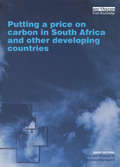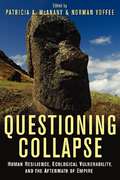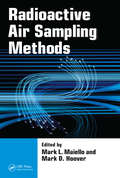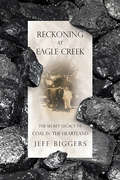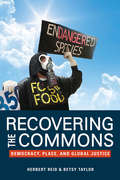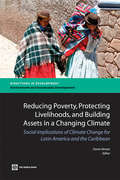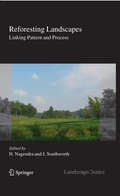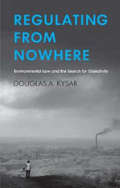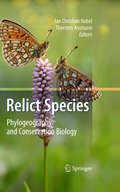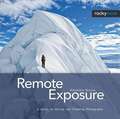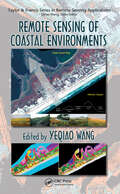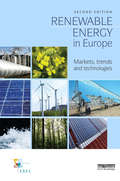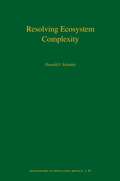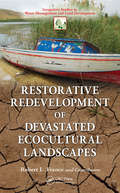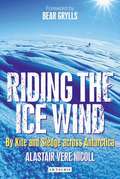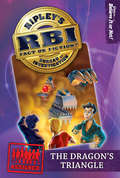- Table View
- List View
Putting a Price on Carbon in South Africa and Other Developing Countries (Climate Policy Ser.)
by Harald WinklerHow should we be putting a price on carbon, particularly in developing countries? This volume takes up this contested issue and examines how different economic instruments might apply in developing countries, with a special focus on South Africa. The papers included address a variety of themes in this area: Emissions trading, carbon taxes, fiscal and non-fiscal instruments, policy and institutional dimensions, and lessons from the Clean Development Mechanism. Presenting the very latest research, the volume will be of interest to academics and policymakers in economics, policy and development.
Questioning Collapse
by Patricia A. Mcanany Norman YoffeeQuestioning Collapse challenges those scholars and popular writers who advance the thesis that societies - past and present - collapse because of behavior that destroyed their environments or because of overpopulation. In a series of highly accessible and closely argued essays, a team of internationally recognized scholars bring history and context to bear in their radically different analyses of iconic events, such as the deforestation of Easter Island, the cessation of the Norse colony in Greenland, the faltering of nineteenth-century China, the migration of ancestral peoples away from Chaco Canyon in the American southwest, the crisis and resilience of Lowland Maya kingship, and other societies that purportedly 'collapsed'. Collectively, these essays demonstrate that resilience in the face of societal crises, rather than collapse, is the leitmotif of the human story from the earliest civilizations to the present. Scrutinizing the notion that Euro-American colonial triumphs were an accident of geography, Questioning Collapse also critically examines the complex historical relationship between race and political labels of societal 'success' and 'failure'.
Radioactive Air Sampling Methods
by Mark L. Maiello Mark D. HooverAlthough the field of radioactive air sampling has matured and evolved over decades, it has lacked a single resource that assimilates technical and background information on its many facets. Edited by experts and with contributions from top practitioners and researchers, Radioactive Air Sampling Methods provides authoritative guidanc
Reckoning at Eagle Creek: The Secret Legacy of Coal in the Heartland (Shawnee Bks.)
by Jeff BiggersCultural historian Jeff Biggers takes us to the dark amphitheatre ruins of his family’s nearly 200-year-old hillside homestead that has been strip-mined on the edge of the first federally recognized Wilderness Site in southern Illinois. In doing so, he not only comes to grips with his own denied backwoods heritage, but also chronicles a dark and missing chapter in the American experience: the historical nightmare of coal outside of Appalachia, serving as an exposé of a secret legacy of shame and resiliency.
Recovering the Commons: Democracy, Place, and Global Justice
by Herbert Reid Betsy TaylorThis penetrating work culls key concepts from grassroots activism to hold critical social theory accountable to the needs, ideas, and organizational practices of the global justice movement. The resulting critique of neoliberalism hinges on place-based struggles of groups marginalized by globalization and represents a brave rethinking of politics, economy, culture, and professionalism. Providing new practical and conceptual tools for responding to human and environmental crises in Appalachia and beyond, Recovering the Commons radically revises the framework of critical social thought regarding our stewardship of the civic and ecological commons. Herbert Reid and Betsy Taylor ally social theory, field sciences, and local knowledge in search of healthy connections among body, place, and commons that form a basis for solidarity as well as a vital infrastructure for a reliable, durable world. Drawing particularly on the work of philosophers Maurice Merleau-Ponty, John Dewey, and Hannah Arendt, the authors reconfigure social theory by ridding it of the aspects that reduce place and community to sets of interchangeable components. Instead, they reconcile complementary pairs such as mind/body and society/nature in the reclamation of public space. With its analysis embedded in philosophical and material contexts, this penetrating work culls key concepts from grassroots activism to hold critical social theory accountable to the needs, ideas, and organizational practices of the global justice movement. The resulting critique of neoliberalism hinges on place-based struggles of groups marginalized by globalization and represents a brave rethinking of politics, economy, culture, and professionalism.
Recycling
by Saddleback Educational Publishing StaffTeach environmental studies and global warming in the inclusive classroom with these unique informational books. summarizes critical information. The index takes students directly to topics of interest.
Recyclo-gami: 40 Crafts to Make your Friends GREEN with Envy!
by Laurie Goldrich WolfWhat can you make out of your old bits of paper, leftover pieces of yarn, or not-so-brand-new cartons and containers? Craft your own purse out of playing cards, whip up a scrapbook made of cereal boxes, or a dollhouse from an empty juice carton! Tweens and teens can start crafting using the easy to follow instructions and photographic directions the smart way. All crafts are made out of materials that many of us find just lying around the house or sitting on the curb waiting to be tossed in a landfill. Overpriced décor, fashion, and gifts are out, and recyclable crafts are in!
Reducing Poverty, Protecting Livelihoods, and Building Assets in a Changing Climate
by Dorte VernerClimate change is the defining development challenge of our time. More than a global environmental issue, climate change and variability threaten to reverse recent progress in poverty reduction and economic growth. Both now and over the long run, climate change and variability threatens human and social development by restricting the fulfillment of human potential and by disempowering people and communities in reducing their livelihoods options. Communities across Latin America and the Caribbean are already experiencing adverse consequences from climate change and variability. Precipitation has increased in the southeastern part of South America, and now often comes in the form of sudden deluges, leading to flooding and soil erosion that endanger people's lives and livelihoods. Southwestern parts of South America and western Central America are seeing a decrease in precipitation and an increase in droughts. Increasing heat and drought in Northeast Brazil threaten the livelihoods of already-marginal smallholders, and may turn parts of the eastern Amazon rainforest into savannah. The Andean inter-tropical glaciers are shrinking and expected to disappear altogether within the next 20-40 years, with significant consequences for water availability. These environmental changes will impact local livelihoods in unprecedented ways. Poverty, inequality, water access, health, and migration are and will be measurably affected by climate change. Using an innovative research methodology, this study finds quantitative evidence of large variations in impacts across regions. Many already poor regions are becoming poorer; traditional livelihoods are being challenged in unprecedented ways; water scarcity is increasing, particularly in poor arid areas; human health is deteriorating; and climate-induced migration is already taking place and may increase. Successfully reducing social vulnerability to climate change and variability requires action and commitment at multiple levels. This volume offers key operational recommendations at the government, community, and household levels with particular emphasis placed on enhancing good governance and technical capacity in the public sector, building social capital in local communities, and protecting the asset base of poor households.
Reforesting Landscapes
by Jane Southworth Harini NagendraThe 21st century has seen the beginnings of a great restoration effort towards the world's forests, accompanied by the emergence of an increasing literature on reforestation, regeneration and regrowth of forest cover. Yet to date, there is no volume which synthesises current knowledge on the extent, trends, patterns and drivers of reforestation. This edited volume draws together research from leading researchers to explore reforestation and forest regrowth across the world, from multiple dimensions - including ecosystem services, protected areas, social institutions, economic transitions, remediation of environmental problems, conservation and land abandonment - and at different scales. Detailing the methods and analyses used from across a wide range of disciplines, and incorporating research from North, South and Central America, Africa, Asia and Europe, this groundbreaking book provides a global overview of current trends, explores their underlying causes and proposes future forest trajectories. The first of its kind, the book will provide an invaluable reference for researchers and students involved in interdisciplinary research and working on issues relevant to the biophysical, geographic, socioeconomic and institutional processes associated with reforestation.
Regulating from Nowhere: Environmental Law and the Search for Objectivity
by Douglas A. KysarDrawing insight from a diverse array of sources -- including moral philosophy, political theory, cognitive psychology, ecology, and science and technology studies -- Douglas Kysar offers a new theoretical basis for understanding environmental law and policy. He exposes a critical flaw in the dominant policy paradigm of risk assessment and cost-benefit analysis, which asks policymakers to, in essence, "regulate from nowhere. " As Kysar shows, such an objectivist stance fails to adequately motivate ethical engagement with the most pressing and challenging aspects of environmental law and policy, which concern how we relate to future generations, foreign nations, and other forms of life. Indeed, world governments struggle to address climate change and other pressing environmental issues in large part because dominant methods of policy analysis obscure the central reasons for acting to ensure environmental sustainability. To compensate for these shortcomings, Kysar first offers a novel defense of the precautionary principle and other commonly misunderstood features of environmental law and policy. He then concludes by advocating a movement toward environmental constitutionalism in which the ability of life to flourish is always regarded as a luxury wecanafford.
Relict Species
by Jan Christian Habel Thorsten AssmannThis book provides an overview of the importance of research on relict species and presents conclusions and findings on the conservation of these species. There are relict species and populations from nearly all plant and animal groups and they contribute substantially to biodiversity across the globe. Current diversity patterns are influenced by both historic and recent ecological conditions. Relict species are of particular importance, as they usually suffer more severely from human activities than do non-relict populations; the situation is also potentially critical, as many relict species and populations have the potential to colonize large areas when the climate changes. The more than 27 contributions in this book highlight the history and status of today's relict species and populations and apply molecular genetics, morphometry, modelling and conservation biology to describe the past and present situations and to predict future trends of relict species' distribution.
Remote Exposure: A Guide to Hiking and Climbing Photography
by Alexandre BuisseThough many hikers and climbers carry cameras with them, they often come away feeling disappointed because their images fail to visually translate their experiences. In Remote Exposure Alexandre Buisse goes beyond the mere basics of photography and gives you the tools needed to create images that are not only of good technical quality but that are compelling as well. This book will guide you through the various options for equipment, since the requirement for lightweight gear that is able to withstand cold, adverse weather conditions presents unique challenges. Learn about the importance of having an efficient carrying system and a logical, planned workflow. Throughout the book you will find advice on where to point your camera and how to compose a strong image. Included are specific requirements for rock climbing, hiking, mountaineering, and camping. More advanced photographic topics are also covered such as digital capture and optimization techniques like high dynamic range imaging (HDRI), panoramic stitching, and how to achieve excellent results without a tripod. The pages are filled with over 100 stunning images captured by Buisse as he hiked and climbed through mountain ranges on three continents. Photographers of all levels and those who just appreciate beautiful images are sure to be inspired by this book. Foreword by Cory Richards (member of the historic climbing expedition that reached the summit of Gasherbrum II in winter).
Remote Sensing of Coastal Environments (Remote Sensing Applications Series)
by Yeqiao WangAs coastal environments around the world face unprecedented natural and anthropogenic threats, advancements in the technologies that support geospatial data acquisition, imaging, and computing have profoundly enhanced monitoring capabilities in coastal studies. Providing systematic treatment of the key developments, Remote Sensing of Coastal Enviro
Renewable Energy in Europe: Markets, Trends and Technologies
by European Renewable European Renewable Energy CouncilHow can the European Union meet its binding 20% renewable energy target in final energy consumption by the year 2020? Which sources offer the best prospects for realizing this goal? These are the questions answered by this key book which analyses the current situation of renewable energy in Europe, examines the latest technological, financial and economic developments, and outlines ways in which the renewable energy market can be developed. The book is divided into sections examining the integration of renewable energy, electricity, heating and cooling as well as biofuels. All the main technologies are covered, with exploration of: ' benefits and applications ' costs and prices ' markets and installed capacity ' policy instruments ' key countries and success stories ' targets and long term potential This will be essential reading for policy decision-makers at all levels and to all those involved in the development of the renewable energy industry.
Replenishing the Earth Spiritual Valued for Healing Ourselves and the World
by Wangari MaathaiAn impassioned call to heal the wounds of our planet and ourselves through the tenets of our spiritual traditions, from a winner of the Nobel Peace Prize. It is so easy, in our modern world, to feel disconnected from the physical earth. Despite dire warnings and escalating concern over the state of our planet, many people feel out of touch with the natural world. Nobel laureate Wangari Maathai has spent decades working with the Green Belt Movement to help women in rural Kenya plant--and sustain--millions of trees. With their hands in the dirt, these women often find themselves empowered and "at home" in a way they never did before. Maathai wants to impart that feeling to everyone, and believes that the key lies in traditional spiritual values: love for the environment, self-betterment, gratitude and respect, and a commitment to service. While educated in the Christian tradition, Maathai draws inspiration from many faiths, celebrating the Jewish mandate tikkun olam ("repair the world") and renewing the Japanese term mottainai ("don't waste"). Through rededication to these values, she believes, we might finally bring about healing for ourselves and the earth.
Requiem for a Species: Why We Resist the Truth About Climate Change
by Clive HamiltonClive Hamilton offers a compelling description of a world transformed by climate change and explains why we won't stop climate change even though we know it will destroy us. This book does not set out to raise the alarm again to encourage us to take radical measures to head off climate chaos. There have been many books and reports in recent years explaining just how dire the future looks and how little time we have left to act. This book is about why we have ignored those warnings, and why it may now be too late. It is a book about the frailties of the human species as expressed in both the institutions we built and the psychological dispositions that have led us on the path of self-destruction. It is about our strange obsessions, our hubris, and our penchant for avoiding the facts. It is the story of a battle within us between the forces that should have caused us to protect the Earth, "our capacity to reason and our connection to Nature "and those that, in the end, have won out "our greed, materialism and alienation from Nature. And it is about the 21st century consequences of these failures.
Resolving Ecosystem Complexity (Monographs in Population Biology #47)
by Oswald J. SchmitzAn ecosystem's complexity develops from the vast numbers of species interacting in ecological communities. The nature of these interactions, in turn, depends on environmental context. How do these components together influence an ecosystem's behavior as a whole? Can ecologists resolve an ecosystem's complexity in order to predict its response to disturbances? Resolving Ecosystem Complexity develops a framework for anticipating the ways environmental context determines the functioning of ecosystems. Oswald Schmitz addresses the critical questions of contemporary ecology: How should an ecosystem be conceptualized to blend its biotic and biophysical components? How should evolutionary ecological principles be used to derive an operational understanding of complex, adaptive ecosystems? How should the relationship between the functional biotic diversity of ecosystems and their properties be understood? Schmitz begins with the universal concept that ecosystems are comprised of species that consume resources and which are then resources for other consumers. From this, he deduces a fundamental rule or evolutionary ecological mechanism for explaining context dependency: individuals within a species trade off foraging gains against the risk of being consumed by predators. Through empirical examples, Schmitz illustrates how species use evolutionary ecological strategies to negotiate a predator-eat-predator world, and he suggests that the implications of species trade-offs are critical to making ecology a predictive science. Bridging the traditional divides between individuals, populations, and communities in ecology, Resolving Ecosystem Complexity builds a systematic foundation for thinking about natural systems.
Resource Economics
by Jon M. ConradResource Economics is a text for students with a background in calculus and intermediate microeconomics and a familiarity with the spreadsheet software Excel. The book covers basic concepts (Chapter 1), shows how to set up spreadsheets to solve simple dynamic allocation problems (Chapter 2), and presents economic models for fisheries, forestry, nonrenewable resources, and stock pollutants (Chapters 3-6). Chapter 7 examines the maximin utility criterion when the utility of a generation depends on consumption of a manufactured good, harvest from a renewable resource, and extraction from a nonrenewable resource. Within the text, numerical examples are posed and solved using Excel's Solver. Exercises are included at the end of each chapter. These problems help make concepts operational, develop economic intuition, and serve as a bridge to the study of real-world problems in resource management.
Restorative Redevelopment of Devastated Ecocultural Landscapes (Integrative Studies in Water Management & Land Development)
by Robert L. FranceA fusion of ecological restoration and sustainable development, restorative redevelopment represents an emerging paradigm for remediating landscapes. Rather than merely fixing the broken bits and pieces of nature, restorative development advocates the reuse of devastated landscapes to improve the value and livability of a location for humans at the
Restoring Harmony
by Joëlle AnthonyThe year is 2041, and sixteen-year-old Molly McClure has lived a relatively quiet life on an isolated farming island in Canada, but when her family fears the worst may have happened to her grandparents in the US, Molly must brave the dangerous, chaotic world left after global economic collapse one of massive oil shortages, rampant crime, and abandoned cities. Molly is relieved to find her grandparents alive in their Portland suburb, but they're financially ruined and practically starving. What should've been a quick trip turns into a full-fledged rescue mission. And when Molly witnesses something the local crime bosses wishes she hadn't, Molly's only way home may be to beat them at their own game. Luckily, there's a handsome stranger who's willing to help. Restoring Harmony is a riveting, fast-paced dystopian tale complete with adventure and romance that readers will devour.
Return to the Olive Farm (The Olive Farm Series)
by Carol DrinkwaterAt a small farm in Provence, a woman tries to do her part to save the bees—and the planet—in this stirring, entertaining memoir. After a long research trip, Carol Drinkwater is back home with her husband, Michel, on their olive farm in the south of France. She&’s overjoyed, but also has something serious on her mind: the ecological threats to their own farm—and countless others. The die-off of honey bees has reached crisis levels globally, and Carol is concerned about the state of their hives. Some farmers and scientists believe urgent change is needed to address agricultural techniques that are destroying the planet. But when Carol joins their chorus, it may put their beloved farm in jeopardy. It&’s time for a true commitment—but running an organic farm, the couple soon discovers, is not as simple as it sounds . . .Praise for the Olive Farm series &“Vibrant, intoxicating and heartwarming.&” —Sunday Express &“Spellbinding . . . a must for anyone who dreams of moving to a kinder climate and starting a new life.&” —Choice
Review of Closure Plans for the Baseline Incineration Chemical Agent Disposal Facilities
by National Research Council of the National AcademiesThis book responds to a request by the director of the U.S. Army Chemical Materials Agency (CMA) for the National Research Council to examine and evaluate the ongoing planning for closure of the four currently operational baseline incineration chemical agent disposal facilities and the closure of a related testing facility. The book evaluates the closure planning process as well as some aspects of closure operations that are taking place while the facilities are still disposing of agent. These facilities are located in Anniston, Alabama; Pine Bluff, Arkansas; Tooele, Utah; and Umatilla, Oregon. They are designated by the acronyms ANCDF, PBCDF, TOCDF, and UMCDF, respectively. Although the facilities all use the same technology and are in many ways identical, each has a particular set of challenges.
Rhetorics, Literacies, and Narratives of Sustainability (Routledge Studies in Rhetoric and Communication)
by Peter N. GogginIn this volume, rhetoricians, literacy scholars, and humanists have come together to examine the complex discursive constructions of sustainability. Touching on topics including conservation efforts in specific locales; social and political constructions of rhetorical place and space; community literacy; historical and archival analysis of institutional politics, policies, and practices concerning the environment and economic growth and development; town planning and zoning issues; and rhetorics of environmental remediation and sustainability, this collection of essays provides rhetoricians and environmentalists a window into the complex and often contradictory arena of discourse on sustainability.
Riding the Ice Wind: By Kite and Sledge Across Antarctica
by Alastair Vere NicollAlastair Vere Nicoll joined a team of young men to harness the katabatic winds and kite-surf across Antarctica. This is the story of the first West-to-East traverse of Antarctica and of the crossing of two phases in the author's life from youth into manhood, fantasy into reality.
Ripley’s RBI 02: Dragon's Triangle
by Ripley's Believe It Or Not!The coast of Japan is being terrorized by a mysterious creature. The RBI are sent to investigate sightings of red glowing eyes that peer out of sea mists and an enormous beast that breathes fire and tramples cars. A trip to Japan reveals a bizarre inventor and stories of a slumbering sea dragon. Is their mission linked to the old legend of the "Dragon's Triangle" and its tales of disappearing ships?
